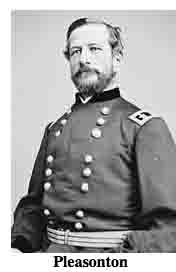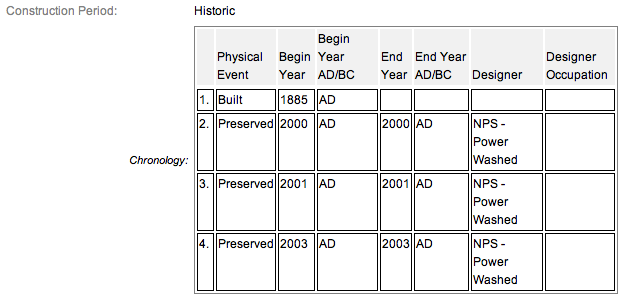
This beautiful, heroic-sized statue is one of 8 statues of historic Civil War figures featured at the Pennsylvania State Memorial. Pleasonton stands in an especially designed niche on the rear or northeast facing of the gigantic memorial. Each of the four sides has two statues, on either end flanking the arch. There are two on the front and moving to the right or counterclockwise, pass the Hancock (No. 3) and Birney (No. 4) statues and this would be in the rear of the monument, after the first position (Gregg No. 5) the second position, and right of the arch, statue No. 6 (by my count). The subject mater, General Pleasonton, commanded the Calvary Corps at Gettysburg.
Major General Alfred Pleasonton (July 24, 1824 – February 17, 1897) was born in Washington, D.C. and died there. Why he was included on the Pennsylvania Monument is a mystery; it is possible that this represents Alfred’s older brother, Augustus, a native of Pennsylvania and West Point graduate, who was a general in the Pennsylvania militia at the time of the battle. He commanded the Cavalry Corps of the Army of the Potomac during the Gettysburg Campaign, including the largest predominantly cavalry battle of the war, Brandy Station. In 1864 he was transferred to the Trans-Mississippi Theater, where he defeated Confederate General Sterling Price in two key battles, effectively ending the war in Missouri. He was the son of Stephen Pleasonton and younger brother of Augustus Pleasonton. Alfred Pleasonton died in his sleep in Washington, D.C., and is buried in the Congressional Cemetery there, alongside his father.
The Pennsylvania State Memorial and the Pleasonton statue are located on Hancock Avenue within a triangular area whose borders consist of Pleasonton Avenue, Humphreys Avenue and Hancock Avenue. The huge Pennsylvania monument faces the southwest.  There is a dedicated parking area to the rear of the memorial which can accommodate nine cars. Additionally, parking is available on the side of the Hancock Avenue (one way only) in white painted spaces. There is also a rest station with bathrooms and a broken water fountain to the right of the parking lot (this is a one way road). This nearby comfort station was completed in 1933 as the first Gettysburg Parkitecture structure. Please be mindful of not parking on the grass or anything green, lest ye be ticketed. I visited this specific statue on July 5, 2012 and again on August 13, 2012, both times in the late afternoon using a Canon PowerShot 14.1 Megapixel, SX210 IS digital camera and a General Electric A1050 10MP Digital Camera with 5X Optical Zoom for the photos.
There is a dedicated parking area to the rear of the memorial which can accommodate nine cars. Additionally, parking is available on the side of the Hancock Avenue (one way only) in white painted spaces. There is also a rest station with bathrooms and a broken water fountain to the right of the parking lot (this is a one way road). This nearby comfort station was completed in 1933 as the first Gettysburg Parkitecture structure. Please be mindful of not parking on the grass or anything green, lest ye be ticketed. I visited this specific statue on July 5, 2012 and again on August 13, 2012, both times in the late afternoon using a Canon PowerShot 14.1 Megapixel, SX210 IS digital camera and a General Electric A1050 10MP Digital Camera with 5X Optical Zoom for the photos.
The statue is eight feet high and of bronze. Physically, it is a standing portrait of Gregg, resting on a foot high, rectangular plinth with his last name deeply incised on the front. Birney is dressed in a military jacket, 16 buttons up and down his uniform/jacket (two buttons on either side hidden under his highly hoisted belt). His proper right hand casually dangles at his side, his proper left hand clasps his belt (no buckle) and he is in a relaxed pose. His sword is positioned slightly to his left (your right). The underside of his left forearm rests upon the hilt of the sword, the business end, resting in the plinth. He wears riding boots which rise just above the knee, creased in various places. He is sort of thrust forward, his proper right leg positioned slightly in front of the left. He gazes with squinted eyes slightly to his right or about due east, another gazing sentinel, his head looking slightly up to the horizon. He wears a hat with a wide brim, resting just above the eyes and thrust back a bit off his crown and slightly cocked to his left. He has neatly trimmed beard connected to an equally trimmed mustache. Overall, the statue is very real with wrinkles in the clothes, detail everywhere and a sense of realism.
Construction on the memorial began in the summer of 1909. However, at the time of the dedication on Sept. 27, 1910, the eight portrait statues Cottrell (architect W. Liance Cottrell was selected amongst artists who submitted designs) envisioned for the niches on either side of each archway were missing due to the lack of funds. In the year following the dedication, an additional $40,000 as appropriated to create the statues, and the Van Amringe Granite Company as given the contract. The statues were cast at the Gorham Manufacturing Company and were installed in April of 1913 and the entire memorial was rededicated July 4, 1913. The artists specifically responsible for the Pleasonton statue are sculptor Otto J. Schweizer (1863-1955), Cottrell, W. Liance, architect, Harrison Granite Company, fabricator, Gorham Manufacturing Company, founder and Van Amringe Granite Company, fabricator.
From the SIRIS site: In 1907, $150,000 was appropriated to erect a suitable memorial to honor all Pennsylvanians who participated in the battle at Gettysburg. The design submitted by architect W. Liance Cottrell was selected and the Harrison Granite Company was chosen to execute the design. Construction on the memorial began in the summer of 1909. However, at the time of the dedication on Sept. 27, 1910, the eight portrait statues Cottrell envisioned for the niches on either side of each archway were missing due to the lack of funds. In the year following the dedication, an additional $40,000 as appropriated to create the statues, and the Van Amringe Granite Company as given the contract. The statues were cast at the Gorham Manufacturing Company and were installed in April of 1913. The total cost for the memorial was $200,000.
The Pennsylvania State Memorial (and Pleasonton Statue) is a contributing feature to the Gettysburg National Military Park Historic District which is nationally significant under NR Criteria A, B, C & D. Areas of Significance: Military, Politics/Government, Landscape Architecture, Conservation, Archeology-Historic. Period of Significance: 1863-1938. The original National Register Nomination was approved by the Keeper March 19, 1975. An update to this nomination was approved by the Keeper on January 23, 2004. The monument and statues are identified as structure number MN260.
From the Nomination Form:
1 of 19 Civil War State & National Memorial Monuments of the GBMA Era (1863-1895). Built to commerate Pennsylvania officers & soldiers serving at Gettysburg campaign. Designed by 6 sculptors: Samuel A. Murray, J. Otto Schweizer, W. Clark Noble, Lee O. Lawrie, Cyrus E. Dallin, J. Massey Rhind.
Short Physical Description:
Mn is a 4 sided raised pedestal w/bronze tablets (34"x72") listing PA soldiers. Set on 100' sq. base. Arched passages lead to domed interior. Dome is topped w/bronze winged victory. Double bronze statues located in niches on all 4 sides. 4 oversized reliefs adorn the upper observation deck walls.
Long Physical Description:
Monument is a four-sided raised granite pedestal with bronze tablets listing Pennsylvania soldiers and set on a 100 foot square base. It has arched central passages to the domed interior. The dome is topped with a bronze winged victory. Double bronze statues are located in niches on all four sides. Four oversized granite reliefs adorn the upper observation deck parapet walls. A concrete pathway leads from Hancock Avenue to the monument in a Y shape. Designed by W. Liance Cottrell and sculptured by various American artists, including Samuel Murray, J. Massey Rhind, and J. Otto Schweizer. Located on the east side of Hancock Avenue.
Concrete pathway leads from Hancock Ave. to mn in a Y shape.

My Sources
1.
NRHP Narrative
2.
SIRIS
3.
Stone Sentinels
4.
Virtual Gettysburg
5.
Draw the Sword
6.
Wikipedia
7.
Wikipedia
8.
Dcmemorials